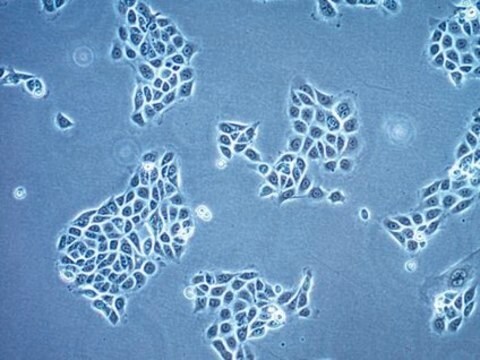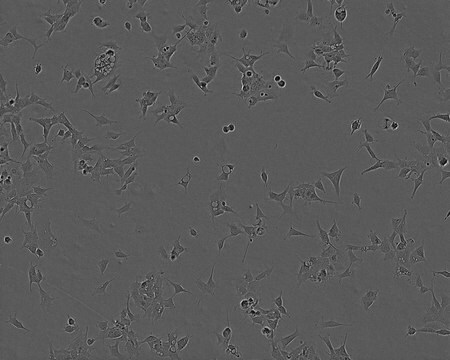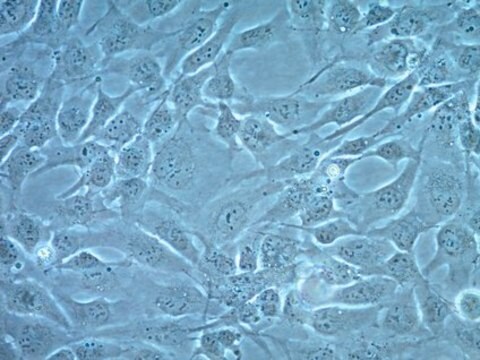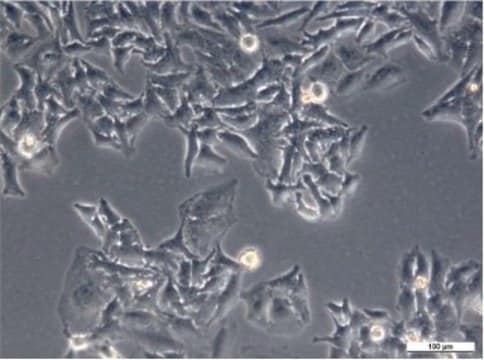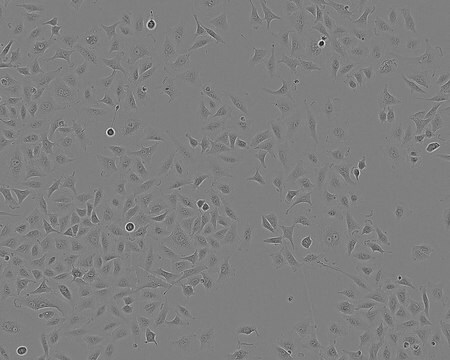SCC160
CFBE41o- 6.2 WT-CFTR Human CF Bronchial Epithelial Cell Line
Human
Sinónimos:
CFBE41o, CF41o, CFBE
About This Item
Productos recomendados
product name
CFBE41o- 6.2 WT-CFTR Human CF Bronchial Epithelial Cell Line, CFBE41o- 6.2 WT-CFTR human CF bronchial epithelial cell line is used to study the relationship between CFTR mRNA expression and Cl transport function.
biological source
human
technique(s)
cell based assay: suitable
cell culture | mammalian: suitable
shipped in
ambient
General description
CFBE41o- 6.2 WT-CFTR Human CF Bronchial Epithelial Cell line is a subclone derived from the electroporation of the parental CFBE41o- cell line with an Epstein-Barr virus (EBV)-based episomal pCEP4β vector containing the 6.2 kb full length wtCFTR cDNA and a Hygromycin B resistance gene . The 6.2kb wtCFTR cDNA contains both the 5’ and 3’ UTR sequences that are known to affect translational efficiency and mRNA stability. The parental CFBE41o- is a CF human bronchial epithelial cell line, derived from a CF patient homozygous for the ΔF508 CFTR mutation and immortalized with the origin-of-replication defective SV40 plasmid (pSVori-) .
In CFBE41o- 6.2 WT-CFTR cells, the levels of vector-driven wt-CFTR mRNA were found to be significantly higher than endogenous CFTR mRNA levels in normal 16HBE14o- bronchial epithelial cell (Cat. No. SCC150). However, cAMP-dependent Cl currents generated in CFBE41o- 6.2 WT-CFTR cells were not as high as those observed in 16HBE14o- cells, which express endogenous CFTR. Established CF bronchial epithelial cell lines that are complemented with either wild-type or ΔF508CFTR mRNA would help provide insights into the relationship between transgene-derived CFTR mRNA expression and rescue of cAMP-dependent Cl transport function.
Cell Line Description
Application
Quality
• Cells are tested by PCR and are negative for HPV-16, HPV-18, Hepatitis A, C, and HIV-1 & 2 viruses as assessed by a Human Essential CLEAR panel by Charles River Animal Diagnostic Services.
• Cells are negative for mycoplasma contamination.
• Each lot of cells is genotyped by STR analysis to verify the unique identity of the cell line.
Storage and Stability
Disclaimer
Unless otherwise stated in our catalog or other company documentation accompanying the product(s), our products are intended for research use only and are not to be used for any other purpose, which includes but is not limited to, unauthorized commercial uses, in vitro diagnostic uses, ex vivo or in vivo therapeutic uses or any type of consumption or application to humans or animals.
Storage Class
10 - Combustible liquids
wgk_germany
WGK 1
flash_point_f
Not applicable
flash_point_c
Not applicable
Certificados de análisis (COA)
Busque Certificados de análisis (COA) introduciendo el número de lote del producto. Los números de lote se encuentran en la etiqueta del producto después de las palabras «Lot» o «Batch»
¿Ya tiene este producto?
Encuentre la documentación para los productos que ha comprado recientemente en la Biblioteca de documentos.
Artículos
16HBE14o- human bronchial epithelial cells used to model respiratory epithelium for the research of cystic fibrosis, viral pulmonary pathology (SARS-CoV), asthma, COPD, effects of smoking and air pollution. See over 5k publications.
Nuestro equipo de científicos tiene experiencia en todas las áreas de investigación: Ciencias de la vida, Ciencia de los materiales, Síntesis química, Cromatografía, Analítica y muchas otras.
Póngase en contacto con el Servicio técnico
